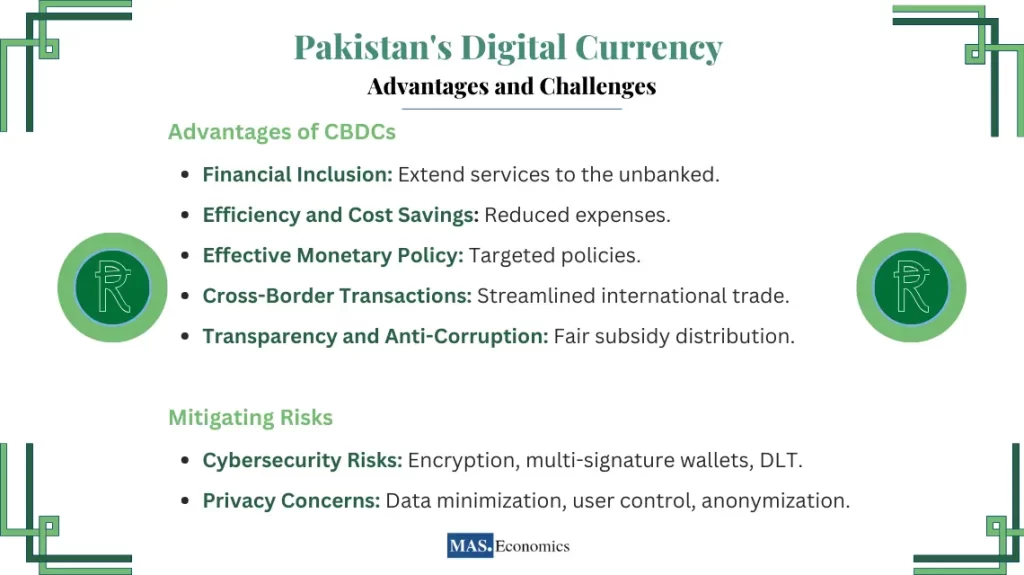Pakistan’s Digital Currency: A Game Changer for the Economy?

[ad_1]
Welcome to MASEconomics, your trusted source for in-depth insights into the rapidly evolving landscape of the economy. Let’s start with the question, are digital currencies issued by central banks the future of finance? In this article, we explore Central Bank Digital Currencies (CBDCs), their potential advantages, Pakistan’s digital currency journey, and the road ahead.
The Rise of CBDCs
Central Bank Digital Currencies (CBDCs) are not just a buzzword; they are a transformative force in the world of finance. Issued and regulated by central banks, CBDCs have gained prominence for their potential to revolutionize the global financial landscape. Pakistan is among the nations that are actively considering the adoption of CBDCs. The State Bank of Pakistan (SBP) has clarified its intentions and is currently in the feasibility analysis phase.
Pakistan’s Digital Currency Vision
Pakistan’s digital currency initiative aligns with global trends. Like China’s digital currency, Pakistan’s CBDC will maintain a one-to-one parity with the Pakistani Rupee. The SBP, supported by industry experts and a dedicated Central Bank Digital Currency department, is diligently crafting a robust digital currency ecosystem. The goal is a seamless transition while ensuring the availability of traditional currency notes as a backup.
The Potential Benefits of CBDCs
CBDCs offer a number of potential benefits, including:

Unlocking Financial Inclusion
One of the most promising aspects of CBDCs is their ability to extend financial services to the unbanked and underbanked. In Pakistan, where 79% of its 231 million people lack access to traditional banking, according to the World Bank’s Global Findex Database, which tracks the use of financial services, a CBDC could serve as a game-changer. Imagine a convenient and affordable means for every Pakistani to make and receive payments.
Efficiency and Cost Savings
Managing physical currency comes at a considerable cost. In Pakistan, these costs amount to over 1% of GDP, according to SBP estimates. CBDCs can significantly reduce these expenses by eliminating the need for printing and distribution. Additionally, the transparency of digital transactions can play a crucial role in combating financial crimes.
A Tool for Effective Monetary Policy
Real-time monitoring of digital transactions provides central banks with invaluable insights. Pakistan’s SBP could employ CBDCs for more targeted monetary policies, such as direct subsidies to low-income households. This precision can lead to better control over inflation, interest rates, and overall economic stability.
Facilitating Cross-Border Transactions
Cross-border trade and remittances often involve multiple intermediaries and high fees. In Pakistan, the average cost of sending a remittance was reported at a staggering 15.51% of the transaction value as of 2020, according to World Bank remittance data. CBDCs can streamline these processes, making international commerce more accessible and cost-effective.
Combating Corruption Through Transparency
Transparency and traceability inherent in CBDCs can aid in reducing corruption. In Pakistan, CBDCs could be used to track government subsidies, ensuring fair and efficient distribution.
Mitigating Risks and Challenges
Although CBDCs hold great promise, they also present significant challenges such as cybersecurity risks and privacy concerns. Pakistan is taking decisive action by collaborating with experts to establish robust security measures and prioritize user privacy.
Cybersecurity Risks
Digital finance is a breeding ground for cyber threats, and CBDCs are no exception. Hacking, fraud, and theft are constant dangers in the digital world. Pakistan acknowledges these challenges and is taking proactive steps to ensure the security of its CBDC, including:
Bulletproof Encryption
Pakistan’s CBDC will employ cutting-edge encryption techniques. Using the latest cryptography algorithms will secure the digital currency from unauthorized access, providing a safe environment for transactions and data.
Multi-Signature Wallets
Pakistan is implementing multi-signature wallets for its CBDC. This means multiple authorized signatures will be necessary to validate and execute transactions. This additional layer of security makes it much more difficult for hackers to compromise the system and steal funds.
Distributed Ledger Technology
Pakistan’s CBDC will be constructed on a distributed ledger technology (DLT) platform. DLT is recognized for its robust security features, making it inherently more secure than traditional centralized systems. The decentralized nature of DLT reduces the risk of a single point of failure, enhancing the resilience of the CBDC infrastructure.
Privacy Concerns
The advent of CBDCs has sparked concerns about user privacy. The ability of central banks to monitor financial transactions raises legitimate privacy concerns. Pakistan is taking a privacy-centric approach to address these concerns:
Minimized Data Collection
Pakistan’s CBDC system is designed to collect only the data necessary for its operation and fraud prevention. This approach ensures that user data is not excessively collected or stored, minimizing the risk of privacy breaches.
User Data Control
Recognizing the significance of individual privacy, Pakistan will empower CBDC users by giving them control over their data. Users can determine how much of their data they wish to share, respecting their privacy preferences.
Anonymization Techniques
Pakistan will implement anonymization techniques to further safeguard user privacy. These techniques will protect the privacy of users’ financial transactions by making it difficult to trace specific transactions back to individuals.
In addition to these technical measures, Pakistan is developing a comprehensive regulatory framework for its CBDC. This regulatory framework will provide clear guidelines for the responsible and secure use of the CBDC, ensuring that it aligns with international best practices and standards.
Conclusion
Pakistan’s digital currency initiative holds the potential to revolutionize the nation’s financial system, foster economic growth, and offer hope for the economy. As we witness this digital evolution, we invite you to share your thoughts on Pakistan’s journey into a future where finance knows no bounds.
If you want to explore the basics of CBDCs and how they differ from other cryptocurrencies, consider reading our article, Discover the Future of Money: Central Bank Digital Currency.
Stay informed, stay ahead, and continue your learning journey with MASEconomics!
[ad_2]

